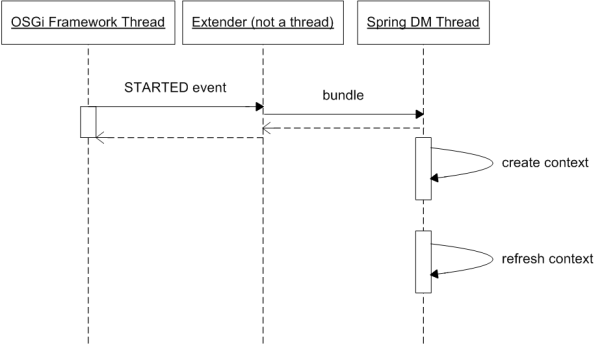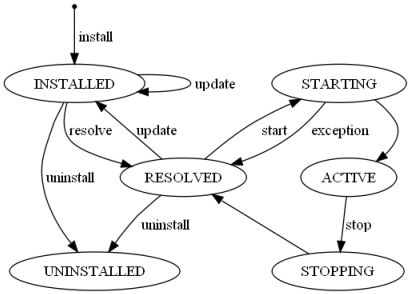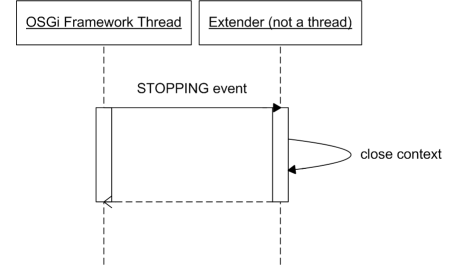

The unit of deployment (and modularity) in OSGi is the bundle (see section 3.2 of the OSGi Service Platform Core Specification). A bundle known to the OSGi runtime is in one of three steady states: installed, resolved, or active. Bundles may export services (objects) to the OSGi service registry, and by so doing make these services available for other bundles to discover and to use. Bundles may also export Java packages, enabling other bundles to import the exported types.
In Spring the primary unit of modularity is an application context, which contains some number of beans (objects managed by the Spring application context). Application contexts can be configured in a hierarchy such that a child application context can see beans defined in a parent, but not vice-versa. The Spring concepts of exporters and factory beans are used to export references to beans to clients outside of the application context, and to inject references to services that are defined outside of the application context.
There is a natural affinity between an OSGi bundle and a Spring application context. Using Spring Dynamic Modules, an active bundle may contain a Spring application context, responsible for the instantiation, configuration, assembly, and decoration of the objects (beans) within the bundle. Some of these beans may optionally be exported as OSGi services and thus made available to other bundles; beans within the bundle may also be transparently injected with references to OSGi services.
This chapter describes the lifecycle relationship between bundles and their application contexts, as imposed by Spring DM based on the events occurring at runtime, inside an OSGi environment.
The component responsible for detecting the Spring-powered bundles and instantiating
their application context is the Spring DM extender. It serves the same purpose as the ContextLoaderListener
does for Spring web applications. Once the extender bundle is installed
and started it looks for any existing Spring-powered bundles that are
already in the ACTIVE state and creates application contexts on their
behalf. In addition, it listens for bundle starting events and
automatically creates an application context for any Spring-powered
bundle that is subsequently started. Section 7.1, “Bundle Format And Manifest Headers”
describes what the extender recognizes as a "Spring-powered bundle" while
Section 7.3, “Extender Configuration Options” how the extender can be configured.
The extender monitors the lifecycle of the bundle it manages and will destroy automatically the contexts for bundles
that are stopped. When the extender bundle itself is stopped, it will automatically close all the contexts that it manages,
based on the service dependency between them.
The extender bundle symbolic name is org.springframework.osgi.extender.
Once started, the extender analyses the existing started bundles and monitors any new bundle that will start. Once a Blueprint or Spring-DM configuration is detected, the extender will create an application context for it in an asynchronous manner, on a different thread then the one starting the bundle (or delivering the STARTED event). This behaviour follows the OSGi specification recommendation and ensures that starting an OSGi Service Platform is fast and that bundles with service inter-dependencies do not cause deadlock (waiting for each other) on startup, as pictured below:

The extender considers only bundles successfully started, that is, bundles in ACTIVE state; bundles in other states are ignored. Therefore a Spring-powered/Blueprint bundle will have its application context created after it has been fully started. It is possible to force synchronous/serialized creation of application contexts for started bundles, on a bundle-by-bundle basis. See Section 7.1, “Bundle Format And Manifest Headers” for information on how to specify this behaviour.
If application context creation fails for any reason then the failure cause is logged. The bundle remains in the ACTIVE state; the application context lifecycle will not influence the bundle lifecycle in anyway. Naturally, since the context has failed, so will the functionality associated with it; for example there will be no services exported to the registry from the application context in this scenario.
If an application context declares mandatory availability for certain imported OSGi services, the creation of the application context is blocked until all the mandatory dependencies can be satisfied through matching services available in the OSGi service registry. In practice, for most enterprise applications built using Spring Dynamic Modules services, the set of available services and bundles will reach a steady state once the platform and its installed bundles are all started. In such a world, the behaviour of waiting for mandatory dependencies simply ensures that bundles A and B, where bundle A depends on services exported by bundle B, may be started in any order.
A timeout applies to the wait for mandatory dependencies to be
satisfied. By default the timeout is set to 5 minutes, but this value
can be configured using the timeout directive. See
Section 7.1, “Bundle Format And Manifest Headers” for details.
Blueprint users could achieve the same result through the blueprint.timeout
attribute declared on the Bundle-SymbolicName
It is possible to change the application context creation semantics so that application context creation fails if all mandatory services are not immediately available upon startup (see the aforementioned section for more information). Again, note that regardless of the configuration chosen, the failure of the application context will not change the bundle state.
For more information on the availability of imported services, see Section 8.2.1, “Imported Service Availability”
Once the application context creation for a bundle has
completed, the application context object is automatically exported as
a service available through the OSGi Service Registry. The context is
published under the interface
org.springframework.context.ApplicationContext (and
also all of the visible super-interfaces and types implemented by the
context). The published service has a service property named
org.springframework.context.service.name whose
value is set to the bundle symbolic name of the bundle hosting the
application context. In case of a Blueprint bundle, the container will be published
under org.osgi.service.blueprint.container.BlueprintContainer
while the bundle symbolic name will be published under osgi.blueprint.container.symbolicname
property.
It is possible to prevent publication of the application context as a service using a directive in the bundle's manifest. See Section 7.1, “Bundle Format And Manifest Headers” for details.
Note: the application context is published as a service
primarily to facilitate testing, administration, and management.
Accessing this context object at runtime and invoking
getBean() or similar operations is discouraged. The
preferred way to access a bean defined in another application context
is to export that bean as an OSGi service from the defining context,
and then to import a reference to that service in the context that
needs access to the service. Going via the service registry in this
way ensures that a bean only sees services with compatible versions of
service types, and that OSGi platform dynamics are respected.
OSGi is a dynamic platform: bundles may be installed, started, updated, stopped, and uninstalled at any time during the running of the framework.
When an active bundle is stopped, any services it exported during its lifetime are automatically unregistered and the bundle returns to the resolved state. A stopped bundle should release any resources it has acquired and terminate any threads. Packages exported by a stopped bundle continue to be available to other bundles.
A bundle in the resolved state may be uninstalled: packages that were exported by an uninstalled bundle continue to be available to bundles that imported them (but not to newly installed bundles).A bundle in the resolved state may also be updated. The update process migrates from one version of a bundle to another version of the same bundle.
Finally of course, a resolved bundle can be started, which transitions it to the active state.
The diagram below represents the bundle states and its transitions:

The OSGi PackageAdmin
refreshPackages operation refreshes packages across
the whole OSGi framework or a given subset of installed bundles. During
the refresh, an application context in an affected bundle will be
stopped and restarted. After a refreshPackages
operation, packages exported by older versions of updated bundles, or
packages exported by uninstalled bundles, are no longer available.
Consult the OSGi specifications for full details.
When a Spring-powered or Blueprint bundle is stopped, the application context
created for it is automatically destroyed. All services exported by the
bundle will be unregistered (removed from the service registry) and the
normal application context tear-down life-cycle is observed
(org.springframework.beans.factory.DisposableBean implementors
and destroy-method
callbacks are invoked on beans in the context).
If a Spring-powered bundle that has been stopped is subsequently re-started, a new application context will be created for it.
The Spring Framework defines a resource abstraction for loading
resources within an application context (see Spring's
resource abstraction). All resource loading is done through the
org.springframework.core.io.ResourceLoader associated with the application
context. The org.springframework.core.io.ResourceLoader is also
available to beans wishing to load resources programmatically. Resource paths with
explicit prefixes - such as classpath: - are treated uniformly
across all application context types (for example, web application
contexts and classpath-based application contexts). Relative resource
paths are interpreted differently based on the type of application
context being created. This enables easy integration testing outside
the ultimate deployment environment.
OSGi 4.0.x specification defines three different spaces from which a resource can be loaded. Spring DM supports all of them through its dedicated OSGi-specific application context and dedicated prefixes:
Table 6.1. OSGi resource search strategies
| OSGi Search Strategy | Prefix | Explanation |
|---|---|---|
| Class Space | classpath: | Searches the bundle classloader (the bundle, all imported packages and required bundles). Forces the bundle to be resolved.
This method has similar semantics to
Bundle#getResource(String) |
| Class Space | classpath*: | Searches the bundle classloader (the bundle and all imported packages and required bundles). Forces the bundle to be resolved.
This method has similar semantics to
Bundle#getResources(String)
|
| JAR File (or JarSpace) | osgibundlejar: | Searches only the bundle jar. Provides low-level access without requiring the bundle to be resolved. |
| Bundle Space | osgibundle: | Searches the bundle jar and its attached fragments (if there are any). Does not create a class loader or force the bundle to be resolved. |
Please consult section 4.3.12 of the OSGi specification for an in depth explanation of the differences between them.
![[Note]](images/admons/note.png) | Note |
|---|---|
If no prefix is specified, the bundle space (osgibundle:) will be used. |
![[Note]](images/admons/note.png) | Note |
|---|---|
Due to the OSGi dynamic nature, a bundle classpath can change during its life time (for example when dynamic imports are used). This might cause different
classpath Resources to be returned when doing pattern matching based on the running environment or target platform. |
All of the regular Spring resource prefixes such as file: and
http: are also supported, as are the pattern matching wildcards.
Resources loaded using such prefixes may come from any location, they
are not restricted to being defined within the resource-loading bundle
or its attached fragments.
OSGi platforms may define their own unique prefixes for accessing
bundle contents. For example, Equinox defines the bundleresource: and
bundlentry: prefixes. These platform specific prefixes may also be
used with Spring OSGi, at the cost, of course, of tying yourself to a
particular OSGi implementation.
Spring Dynamic Modules introduces a new bean scope named bundle. This scope is relevant for
beans exported as an OSGi service and can be described as one instance per bundle.
Beans exported as OSGi service, that have bundle scope, will result in a different instance created for
each unique bundle that imports the service through the OSGi service registry. Consumers of the same bundle (whether defined
through Spring DM or not) will see the same bean instance. When a bundle has stopped importing the bundle (for whatever reason),
the bean instance is disposed.
To the declaring bundle, a bundle-scoped bean behaves just like a singleton (i.e. there is only
one instance per bundle, including the declaring one).This contract lifecycle is similar to that of the
org.osgi.framework.ServiceFactory interface.
For more information regarding service publication and consumption, see Chapter 8, The Service Registry.
![[Important]](images/admons/important.png) | Important |
|---|---|
| The bundle scope is relevant, only if the declaring bean is consumed through the OSGi service registry. That is, instances are created and destroyed (tracked) only when the bean exported as a service, is requested or released as an OSGi service by other bundles. |
In general there is no need to depend on any OSGi APIs when using
the Spring Dynamic Modules support. If you do need
access to the OSGi BundleContext object for your
bundle, then Spring makes this easy to do.
The OSGi application context created by the Spring extender will
automatically contain a bean of type BundleContext
and with name bundleContext. You can inject a
reference to this bean into any bean in the application context either
by-name or by-type. In addition, Spring Dynamic Modules defines the
interface
org.springframework.osgi.context.BundleContextAware:
public interface BundleContextAware { public void setBundleContext(BundleContext context); }
Any bean implementing this interface will be injected with a
reference to the bundle context when it is configured by Spring. If you
wish to use this facility within a bundle, remember to import the
package org.springframework.osgi.context in your
bundle manifest since otherwise the interface will not be visible to your bundle.
The application context is bound to the bundle in which it lives. Thus, if the declaring bundle is being shutdown (for whatever reasons), the application context will be destroyed as well, all exported services being unregistered and all service imported dispose of.
As opposed to the application creation, the application context is destroyed in a synchronized manner, on the same thread that stops the bundle. This is required since once stopped, a bundle can not longer be used (even for class loading) preventing the application context shutdown from executing correctly.

Note that a bundle can be closed individually or as part of a bigger event such as shutting down the entire OSGi platform. In this case or when the extender bundle is being closed down, the application contexts will be closed in a managed manner, based on the service dependencies between them. Please see the next section for more details.
If the extender bundle is stopped, then all the application contexts created by the extender will be destroyed. The algorithm described here is identical to that used by the Blueprint specification (section 121.3.11). Application contexts are shutdown in the following order:
Application contexts that do not export any services, or that export services that are not currently referenced, are shutdown in reverse order of bundle id. (Most recently installed bundles have their application contexts shutdown first).
Shutting down the application contexts in step 1 may have released references these contexts were holding such that there are now additional application contexts that can be shutdown. If so, repeat step 1 again.
If there are no more active application contexts, we have finished. If there are active application contexts then there must be a cyclic dependency of references. The circle is broken by determining the highest ranking service exported by each context: the bundle with the lowest ranking service in this set (or in the event of a tie, the highest service id), is shut down. Repeat from step 1.